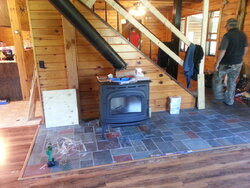@bigaar , i can only think of three reasons to install an oak.
1. competing draft. my next house will have a kitchen exhaust fan rather than a circulating fan in the range hood. clothes dryers can move enough air to compete, kitchen exhaust fans are the more common culprit.
2. tight enough construction to use an hrv. if you are building that tight an oak will save drawing all your combustion air through the filtration system, and make the house side of the system easier to balance.
3. prevailing wind and local topography.
For the first two i would put the oak in with the stove. if you are concerned about the third i would figure out where the oak will fit through the framing, run some burns and onmy install the oak if you need it.
4 actually, some local codes now require oak with new installs.
I have nevwr worked with foam insulation. from reading about it i would install the through floor pipe and spray around it for better final seal rather than soray, cure and cut.
I burn about 8 cords annually in my ashford 30.0. i am burning all spruce this year, 12 hour burns are easily achievable with a tightly stuffed firebix and moderate tstat setting.
I persoanlly would burn the hardwoods in shoulder season where the long coaling phase might get me 24 hour burns in mild weather.
In colder weather i prefer softwoods because they dont have a lengthy coal stage allowing me to refill the box with fresh wood and more dried up sap; keeps the btu output higher.
When i am running the stove hard and see a bed of coals getting bigger and bigger i know its time for softwoods.


 Heck I'm the original creator of the BK performance thread.
Heck I'm the original creator of the BK performance thread. 
 . He is now a believer. As is his wife..... Whew.
. He is now a believer. As is his wife..... Whew.